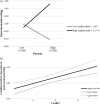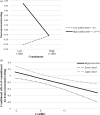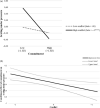Patterns of love and sexting in teen dating relationships: The moderating role of conflicts
- PMID: 34109733
- PMCID: PMC9292559
- DOI: 10.1002/cad.20427
Patterns of love and sexting in teen dating relationships: The moderating role of conflicts
Abstract
According to the triangular love theory, this study investigated the roles of three components of love (i.e., passion, intimacy, commitment) and the moderating role of conflicts in predicting different forms of sexting (i.e., experimental, nonconsensual, under pressure) in teen dating relationships. Participants were 409 adolescents (Mage = 17.20, SDage = 1.61; 62.6% girls) who completed an online questionnaire. Three moderated regressions were performed. Conflicts positively predicted all forms of sexting. Passion positively predicted experimental sexting. Intimacy negatively predicted experimental and nonconsensual sexting, and positively predicted sexting under pressure. Three interaction effects emerged, pointing out the moderating role of conflicts. Passion positively predicted nonconsensual sexting in the presence of high conflicts, while this relationship became negative when conflicts were low. Commitment negatively predicted nonconsensual sexting and sexting under pressure in the presence of high conflicts, but these relationships were not significant when conflicts were low. Research and applicative implications are discussed.
Keywords: adolescents; commitment; conflicts; dating relationships; intimacy; passion; sexting.
© 2021 The Authors. New Directions for Child and Adolescent Development published by Wiley Periodicals LLC.
Conflict of interest statement
The authors declare that they have no conflict of interest.
Figures



Similar articles
-
Cross-sectional analysis of intimacy, passion, and commitment: testing the assumptions of the triangular theory of love.Psychol Rep. 2002 Jun;90(3 Pt 1):1009-14. doi: 10.2466/pr0.2002.90.3.1009. Psychol Rep. 2002. PMID: 12090492
-
Brief report: Intimacy, passion, and commitment in romantic relationships--validation of a 'triangular love scale' for adolescents.J Adolesc. 2007 Jun;30(3):523-8. doi: 10.1016/j.adolescence.2006.12.002. Epub 2007 Feb 22. J Adolesc. 2007. PMID: 17320166
-
Passion, Intimacy, and Commitment in Casual Sexual Relationships in a Canadian Sample of Emerging Adults.J Sex Res. 2018 Nov-Dec;55(9):1192-1205. doi: 10.1080/00224499.2017.1399195. Epub 2017 Dec 4. J Sex Res. 2018. PMID: 29199857
-
Unpacking "Sexting": A Systematic Review of Nonconsensual Sexting in Legal, Educational, and Psychological Literatures.Trauma Violence Abuse. 2017 Dec;18(5):593-601. doi: 10.1177/1524838016659486. Epub 2016 Jul 19. Trauma Violence Abuse. 2017. PMID: 27436858
-
Teenagers, Sexting, and the Law.Pediatrics. 2019 May;143(5):e20183183. doi: 10.1542/peds.2018-3183. Epub 2019 Apr 15. Pediatrics. 2019. PMID: 30988023 Review.
Cited by
-
Motivations, Behaviors and Expectancies of Sexting: The Role of Defensive Strategies and Social Media Addiction in a Sample of Adolescents.Int J Environ Res Public Health. 2023 Jan 18;20(3):1805. doi: 10.3390/ijerph20031805. Int J Environ Res Public Health. 2023. PMID: 36767172 Free PMC article.
-
Love in Quarantine: Sexting, Stress, and Coping During the COVID-19 Lockdown.Sex Res Social Policy. 2023;20(2):465-478. doi: 10.1007/s13178-021-00645-z. Epub 2021 Sep 23. Sex Res Social Policy. 2023. PMID: 34580599 Free PMC article.
-
Sexting Behaviors Before and During COVID-19 in Italian and Colombian Young Adults.Sex Res Social Policy. 2023 Mar 6:1-13. doi: 10.1007/s13178-023-00798-z. Online ahead of print. Sex Res Social Policy. 2023. PMID: 37363349 Free PMC article.
-
Sexting Behaviors and Fear of Missing out Among Young Adults.Behav Sci (Basel). 2025 Apr 1;15(4):454. doi: 10.3390/bs15040454. Behav Sci (Basel). 2025. PMID: 40282076 Free PMC article.
-
The role of sexting in couple wellbeing for Italian women during the second wave of the COVID-19 pandemic.Front Psychol. 2023 Mar 8;14:1105556. doi: 10.3389/fpsyg.2023.1105556. eCollection 2023. Front Psychol. 2023. PMID: 36968735 Free PMC article.
References
-
- Adelman, M. , & Kil, S. H. (2007). Dating conflicts: Rethinking dating violence and youth conflict. Violence Against Women, 13(12), 1296–1318. - PubMed
-
- Aiken, L. S. , & West, S. G. (1991). Multiple regression: Testing and interpreting interactions. Thousand Oaks, CA: Sage.
-
- Alicandro, G. , Bertuccio, P. , Sebastiani, G. , La Vecchia, C. , & Frova, L. (2020). Parental education and cancer mortality in children, adolescents, and young adults: A case‐cohort study within the 2011 Italian census cohort. Cancer, 126(21), 4753–4760. - PubMed
-
- Bianchi, D. , Morelli, M. , Baiocco, R. , & Chirumbolo, A. (2016). Psychometric properties of the Sexting Motivations Questionnaire for adolescents and young adults. Rassegna di Psicologia, 35, 5–18.
-
- Bianchi, D. , Morelli, M. , Baiocco, R. , & Chirumbolo, A. (2017). Sexting as the mirror on the wall: Body‐esteem attribution, media models, and objectified‐body consciousness. Journal of Adolescence, 61, 164–172. - PubMed
MeSH terms
LinkOut - more resources
Full Text Sources

